In the hills of Madagascar a joyous ceremony keeps the deceased close to their kin.
The interior of the crypt is cramped, dark, and slightly damp. Several men, elders of the family, are gathered in the central chamber holding candles and bottles of rum. They’re excited and drunk, laughing and shouting to each other and to the throngs of people waiting outside. The weak light from the candles dances across corpses wrapped in shrouds lining the walls. The shrouds might have been white once, but are now brown and rough. The men search through the corpses looking for the ones to be exhumed. When they find one, they heave it into a reed mat and negotiate the tight corridor out and up into the light.
Stumbling between broken French and even more broken English, a man extends a hand holding a bottle of rum, his eyes wide and glittering with excitable inebriation. “Don’t be afraid! They are our ancestors.” I lower my camera for a moment and gratefully take a couple of slugs from the bottle.
A week earlier, we had arrived in the small farming village of Ambohibary in the central highlands of Madagascar to film a unique ceremony called Famadihana. At first glance, Famadihana is a bizarre, even grotesque, tradition in which the bodies of deceased relatives are exhumed an odd number of years after their deaths. It involves much drinking, eating, and dancing, and culminates in the cemetery. For a day, the unequivocal otherness of the dead is disregarded and they are brought from the crypt to join the party.
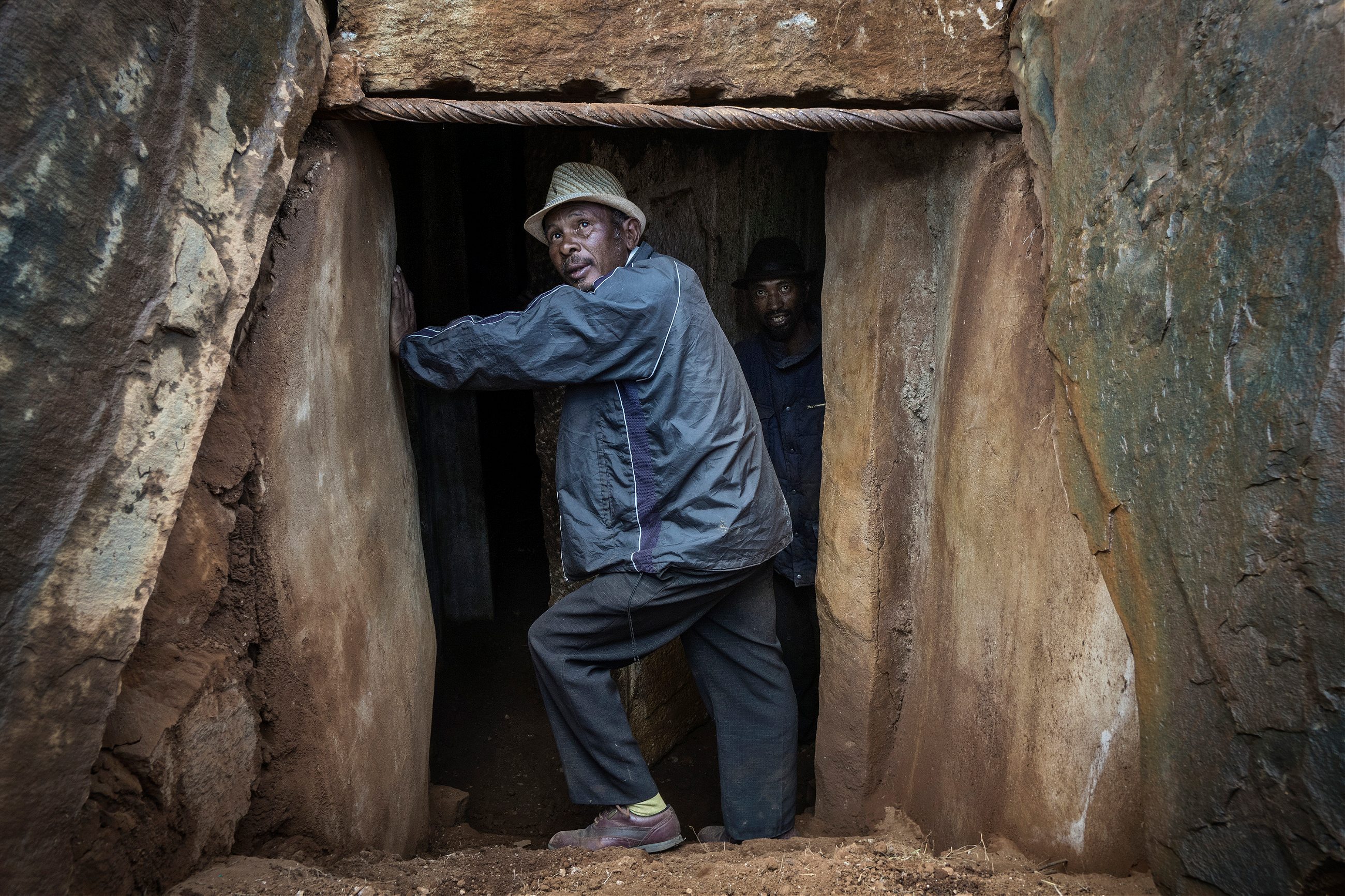
Practiced in Madagascar only by highland communities, the ceremony requires years of preparation leading to an event that can last from two days to a week. Its roots are obscure. It certainly predates the arrival of the missionaries who brought Christianity to the highlands in the early 19th century, but nobody is sure by how long. It is thought that Madagascar was originally populated by Austronesian people who made the improbable journey across the Indian Ocean on outrigger canoes. A tradition similar to Famadihana is practiced in Indonesia, lending credence to the idea that Famadihana has been in Madagascar as long as people have.
Our host in Ambohibary is the head of the family, Jules Rakotoarisoa. A chain-smoking, 65-year- old former truck driver, he’s a quiet patriarch with an observant, slightly preoccupied demeanor. He seems to be constantly mulling over the problems that could arise at any moment. With 300 members of his extended family about to descend on his home, all of whom will need to be fed and entertained, the potential for problems to arise is considerable.
“The Famadihana is an occasion for the whole family to gather and to get to know each other,” he tells us. “It wouldn’t be possible to make a big family gathering for every wedding or death. As exhumation happens only every five, seven or nine years, people have a chance to plan for it. For me, everything has to be done from the heart but this is a task and responsibility.”
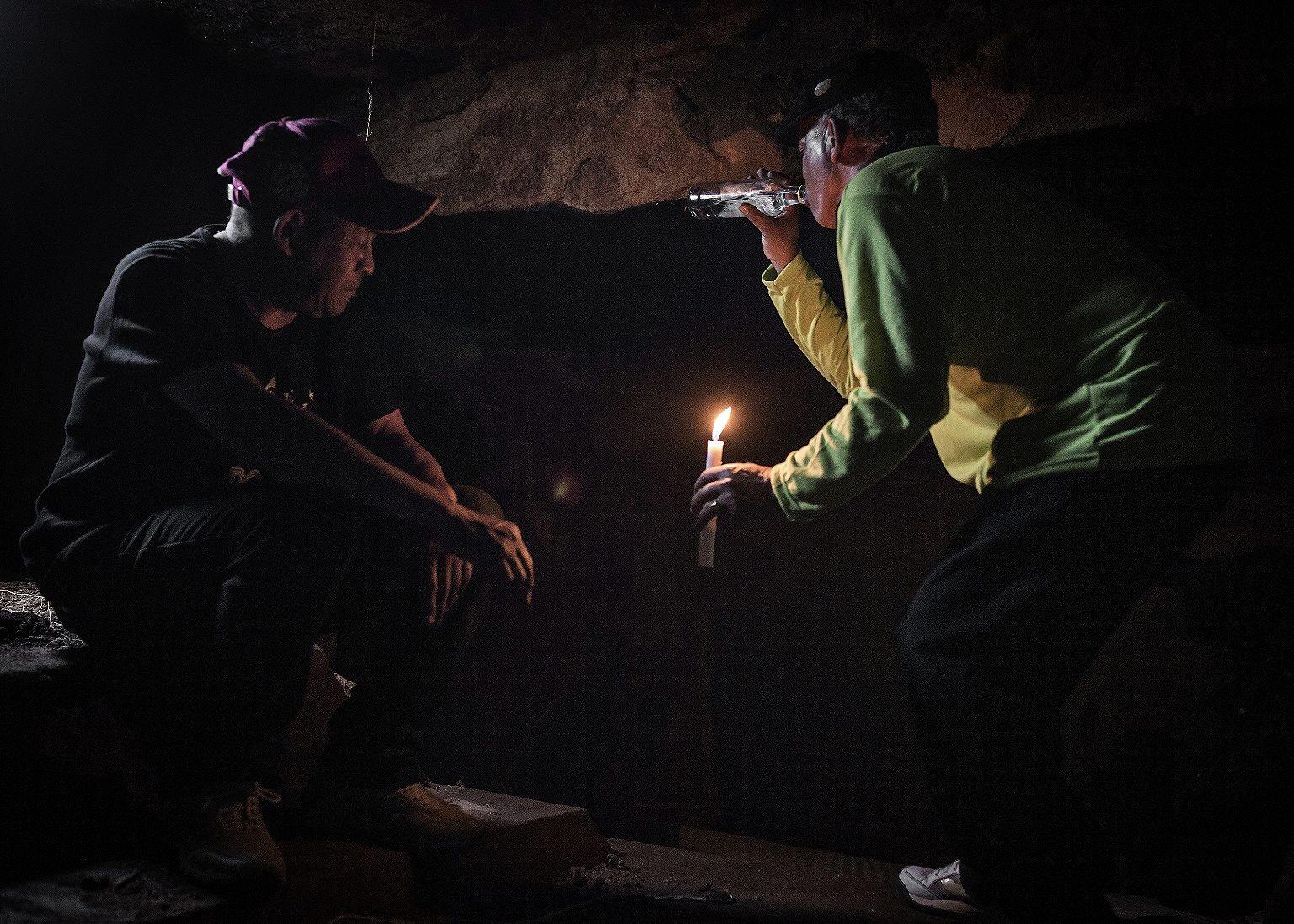
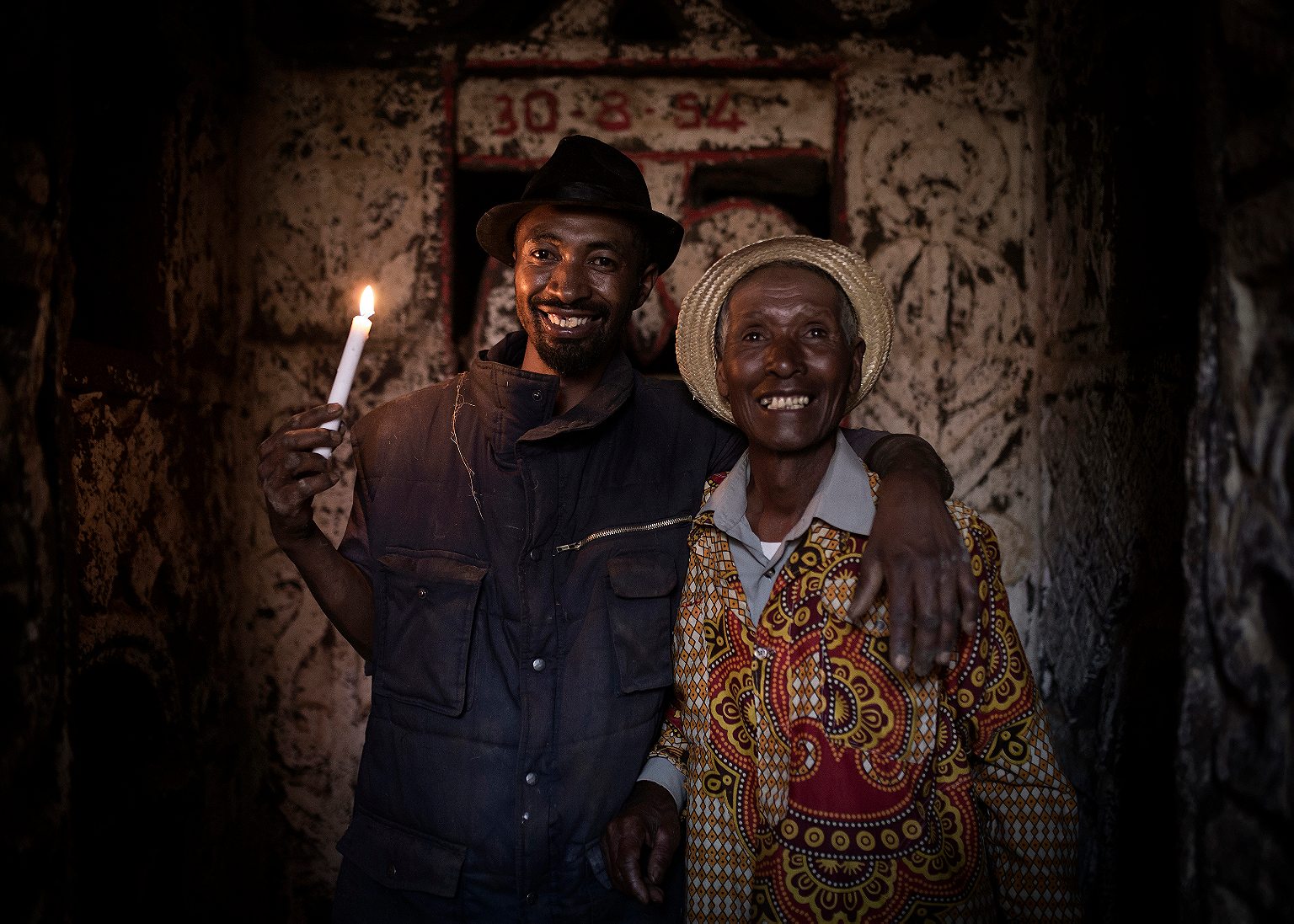
We had come to Madagascar researching a project on the way that death is dealt with in different cultures. The death of my younger brother when I was 21 left me with the sense that there was something cramped and unhealthy in the way that my society—middle-class England—deals with the dead. There was an initial period of mourning during which most people made an effort to accommodate the eccentricity of grief. But it was short, and when it was over there was a feeling that speaking of him would be cruel to whomever I happened to be with. That it was unfair to challenge those around me with a subject that was too big, too tragic, still too taboo, to appear in the patter of everyday conversation.
But when someone you are close to dies, it’s difficult to accept that they have not just gone from your intimate, familiar world, but that they are also no longer welcome in your social world. Your beloved relative has become a conversational tripwire. This strange new quality they have acquired—that of being dead—is apparently distasteful to many. Mention of my brother would trigger a brow furrowed in concern, an awkward stammer, or a clammy and uninvited hand on my arm. Sometimes it would be met by a look of outright fear.
The problem is that after people die, they continue to affect you in much the same way that they did when they were alive. Sure, you can’t see them or touch them, but they still provoke feelings in you. You don’t love them any less. They can still be infuriating (in fact, if anything, they become even more so) or make you laugh. Without speaking of ghosts or God it’s possible to say that you still have a relationship with the dead. Yet—at least in polite English society—it has become a relationship tinged with taboo. A relationship that most people are not equipped to understand, and not inclined to tackle.
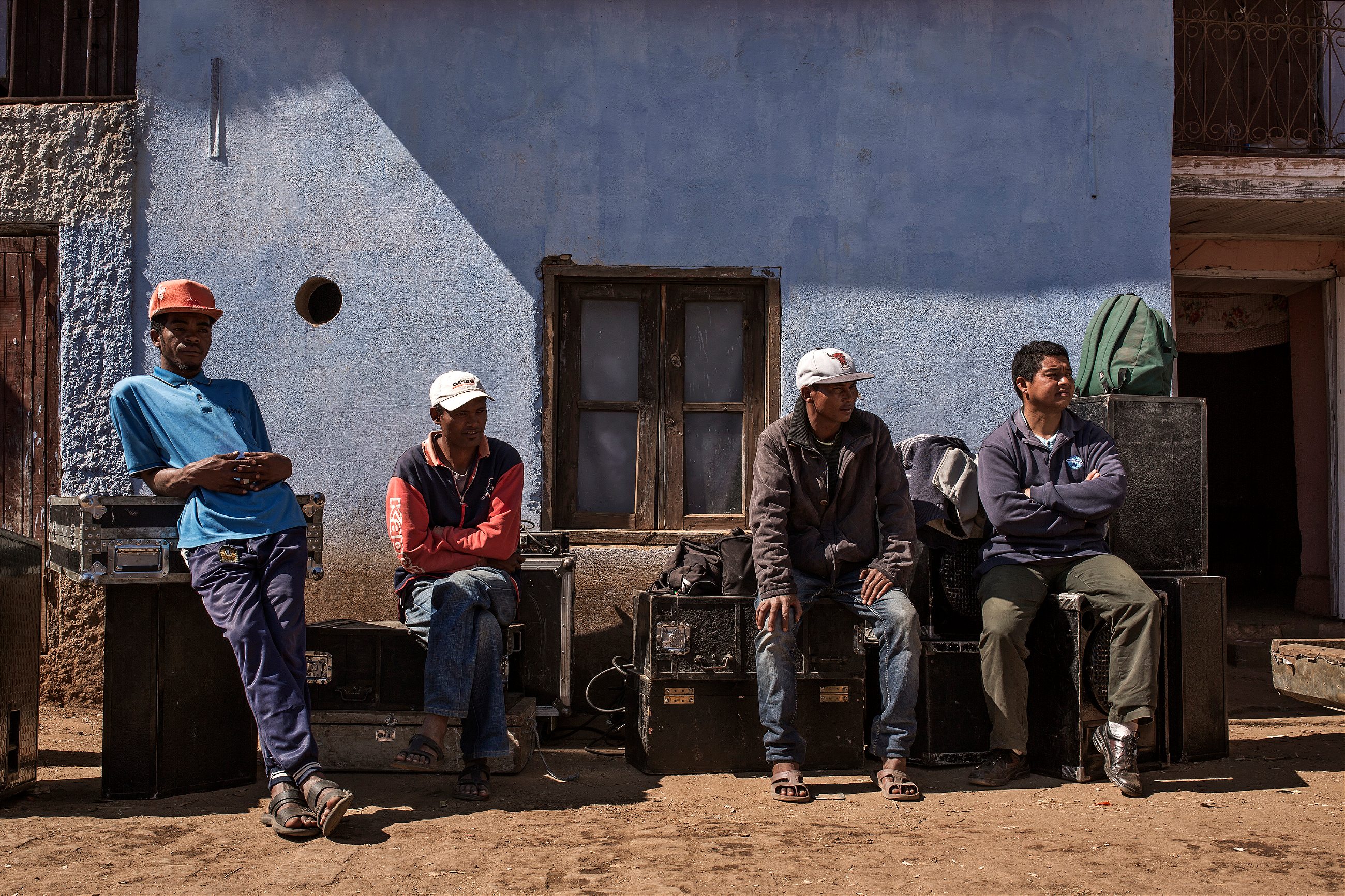
The day before the exhumation most of the guests have arrived and preparations are well under way. A giant and ropey looking sound system is unloaded from the back of a truck. The street outside Jules’ house has been closed off and covered with a lean-to of timber and tarpaulin to demarcate a dance floor. Certain rituals are observed: a chicken is slaughtered and its blood spilled on the ground where the food will be prepared. The men bless the house with rum, a slightly tongue-in-cheek process with as much poured down throats as on the ground.
That night the music starts: pounding Malagasy dance music that the ancient speakers render into almost white noise. The first on the dance floor are the local drunks and kids, the former swaying and staggering from side to side while the kids dart around them like a school of little fish around whales. They laugh and yell and pull impressive moves. Jules circulates, greeting newcomers, keeping an eye on everything, and occasionally taking a turn across the dance floor. His normally inscrutable face is split by a big grin, a cigarette dangling from the corner of his mouth.
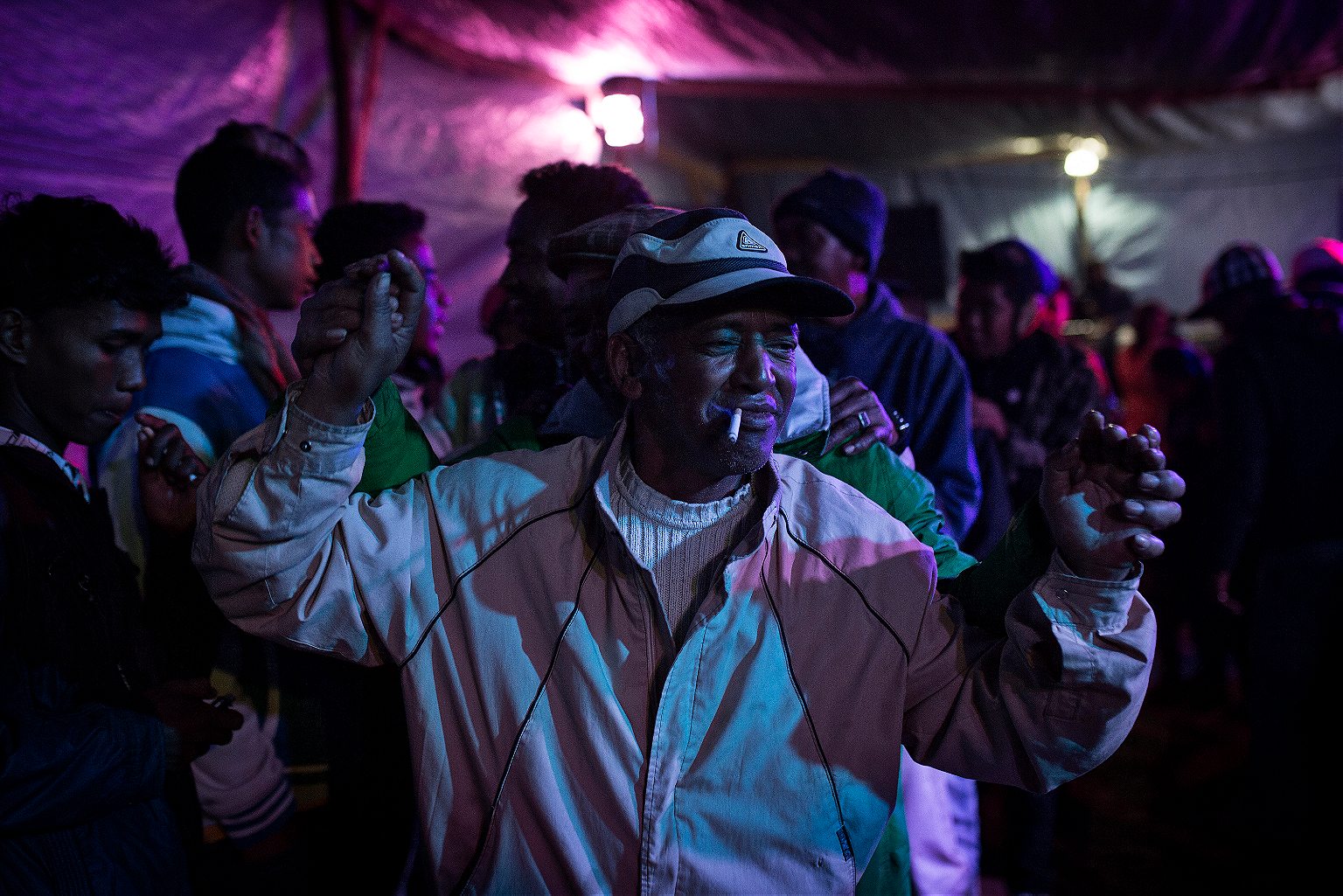
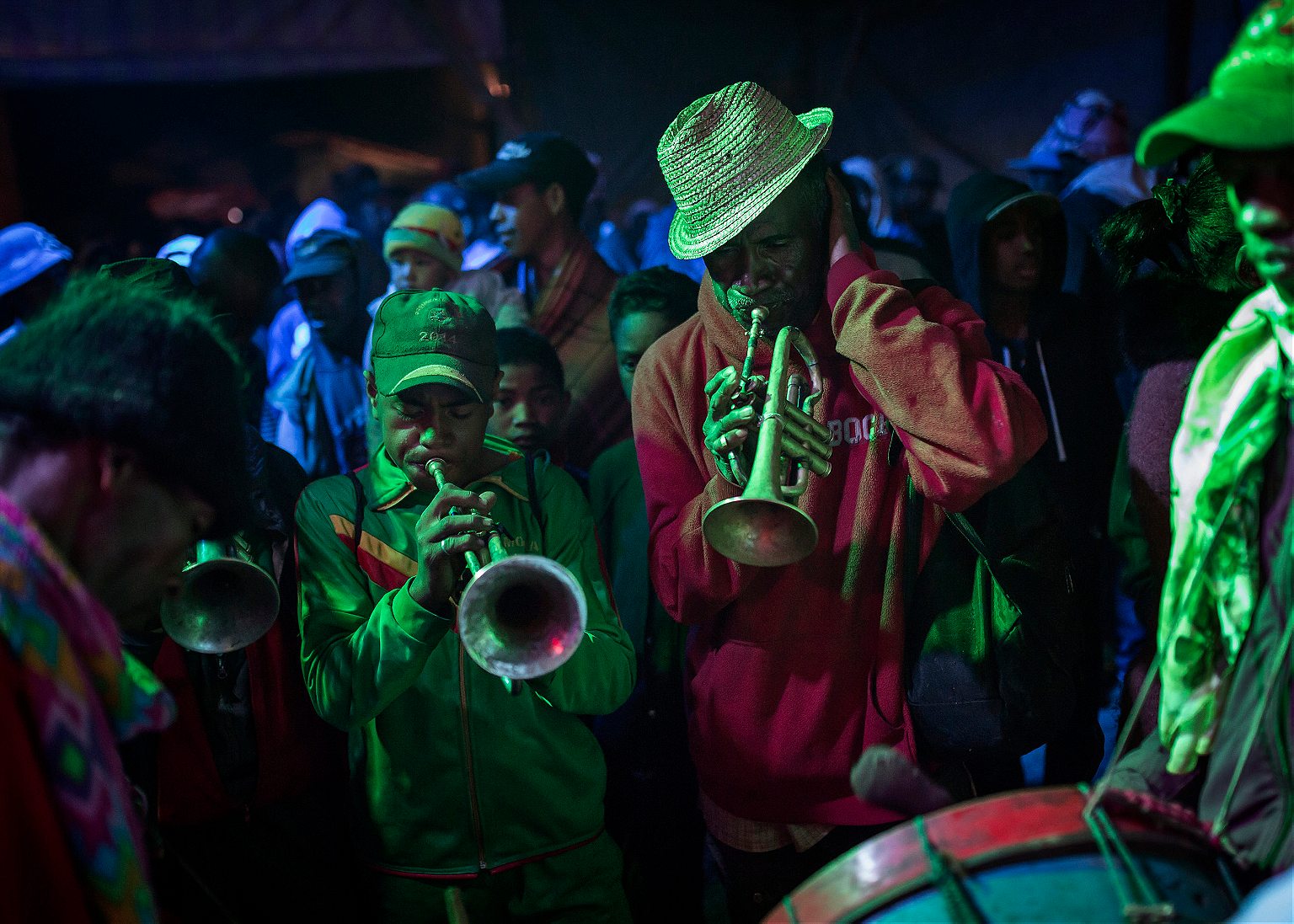
As the dance floor fills, it becomes an unexpectedly familiar scene. There’s the tipsy uncle dancing badly. Made-up teenagers huddle in groups, self-consciously pretending not to check everyone else out. At one point, a drunk hassles someone. He’s already been given a couple of chances and this time, Jules decides he needs to go. He grabs him by the collar and they reel towards the exit in that peculiar, wallowing tango seen late at night in bars across the world. Ten minutes later, they’re hugging and shaking hands; no hard feelings.
This evening, there’s no hint of anything funerary or morbid. The atmosphere is reminiscent of the overblown family celebrations that most of us have attended at some point, willingly or otherwise. All the familiar characters are there. All the loaded looks, the affections and resentments, pettiness and generosity are on display. All the glorious mess that is a big, extended family coming together.
“The most important message of the Famadihana is love for family,” explains Jules. “If one member of the family has a dispute or fight with another, during the exhumation they should be reminded to love each other by seeing the bones, the end of human life. It reminds us to love each other within our lifetimes, while we are alive.”
THE DEAD ARE FAMILY AND SHOULD NOT BE FORGOTTEN
Looked at like this, a kind of social pragmatism begins to undermine the exoticism and grotesquery of the Famadihana. The dead are family and should not be forgotten or left out. Not only out of respect or affection for their memory, but because they still have something to offer. They bind us together and put momentary concerns into perspective. It’s possible to use the love felt for the dead to bolster and fortify the love you have for the living.
The next morning, 300 or so guests gather again under a cloud of hangover. The whole village has turned out to be fed by Jules and they wait outside his house for their turn to file in and sit at long wooden tables where harried but cheerful family members serve them rice and pork.
Around one, lunch is done. A band has arrived and they loll against a wall, some nursing hangovers from the night before while others have clearly tried the hair of the dog. They wear green tracksuits and flip-flops and their instruments look like Cubist illustrations of instruments: bent tubes, tape, and string.


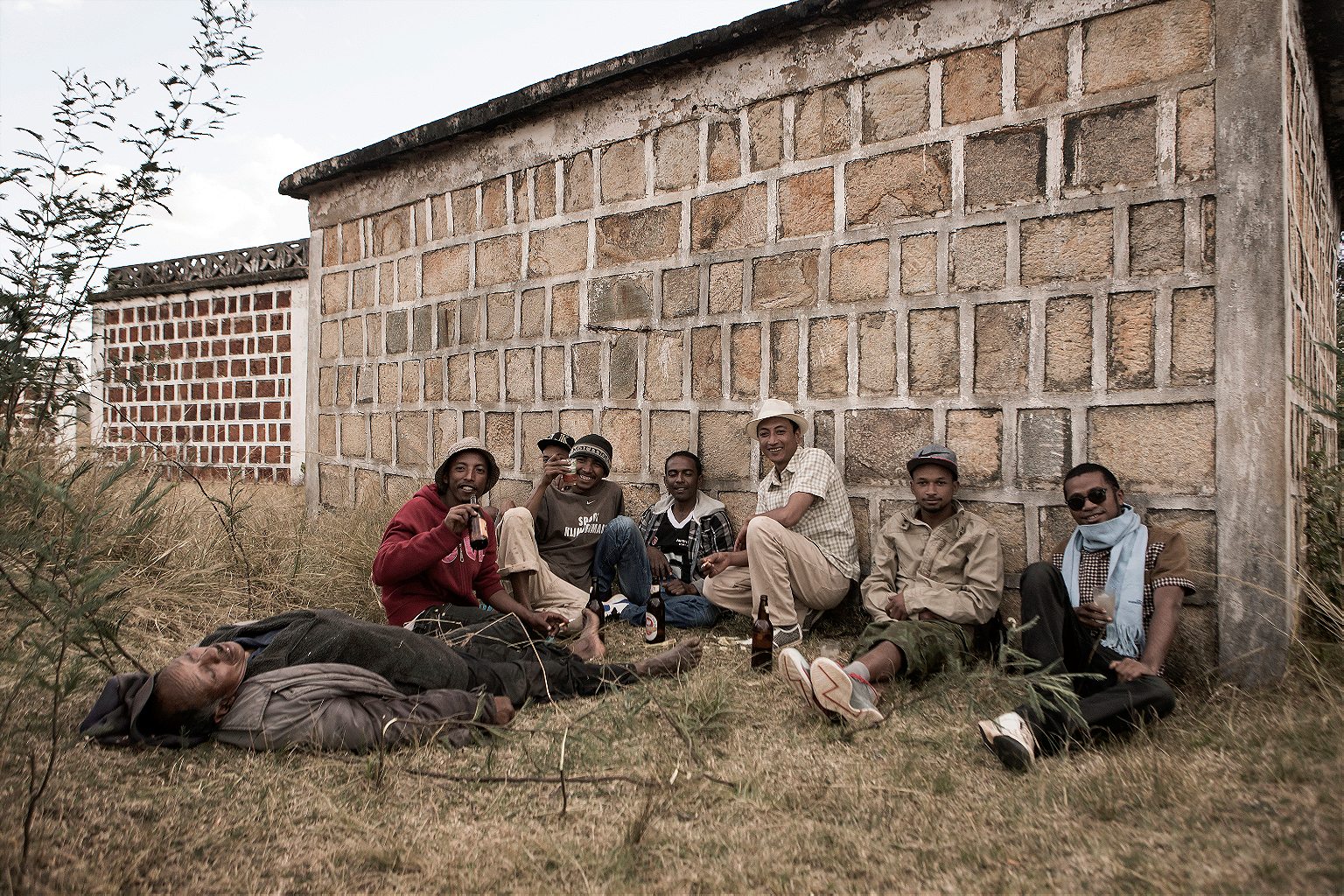
At a signal from Jules they begin to play. A procession forms to head to the cemetery, which lies a mile or so out of town. The teenagers take the lead, whooping and dancing and waving a Malagasy flag. The band plays crazy, broken marching music which sounds drunk itself, all pace and no sense. But there’s enough rhythm to dance to and it keeps everyone moving.
As we move towards the village’s outskirts, the main body of the procession peels off and heads down a side road towards a big family house. The homeowners open the gate and then stand aside while everyone files in and dances and yells in their front yard for five minutes before turning around and heading back to the main road. Amir, our translator, tells me that some of the dead who will be exhumed used to live in that house and that their spirits needed to be picked up on the way to the party.
It takes half an hour to reach the cemetery, which lies on top of a hill. By the time we do, everyone’s a little puffed and some collapse on the scrappy grass to catch their breath. A festival atmosphere prevails, with stalls selling beer, rum, and food. The earthen bank around the Rakotoarisoa crypt is full of people who have arrived early to get a seat.
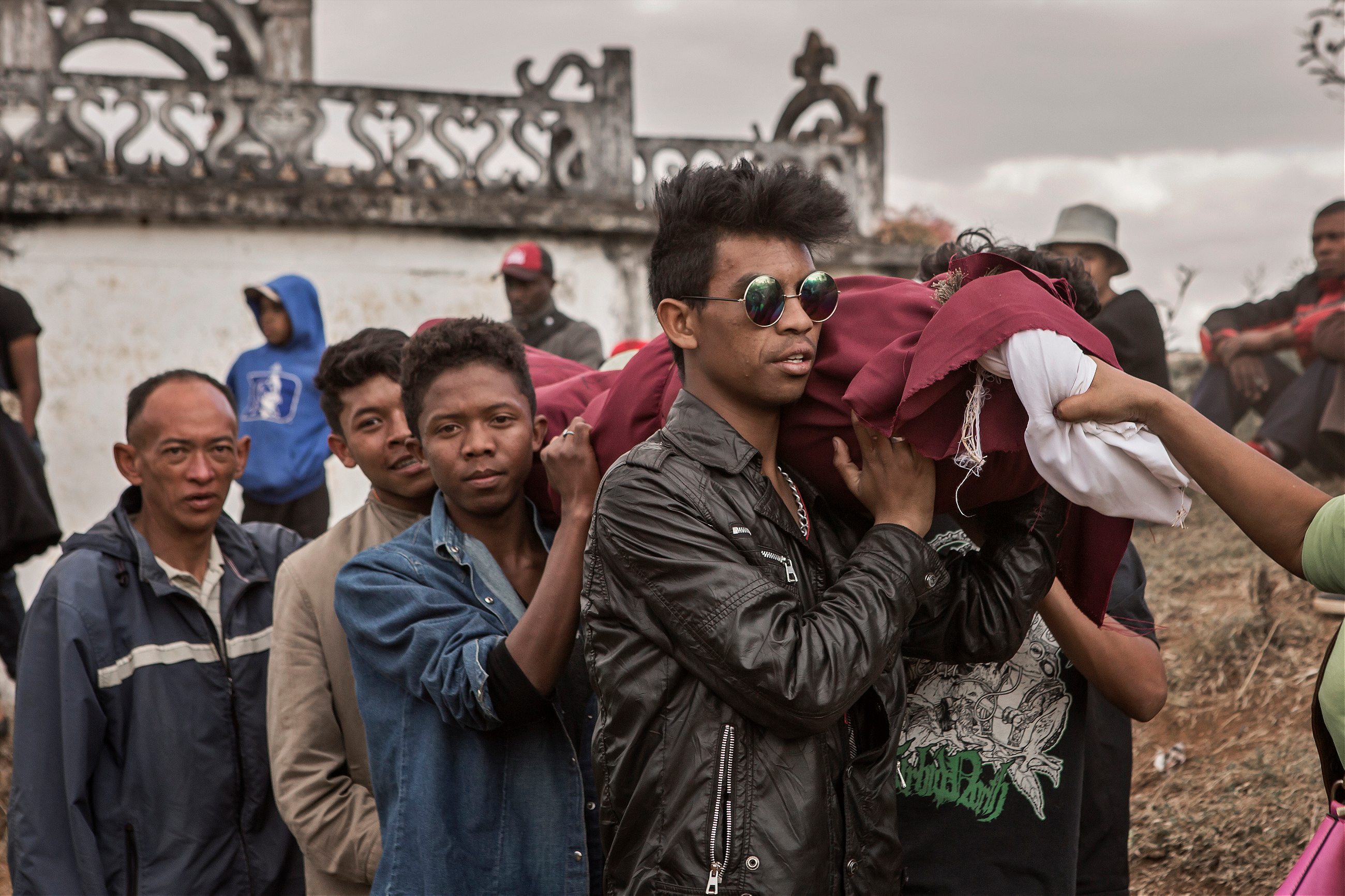
The crypt is about the size of a small house, built of brick and painted in pretty shades of blue and white. The door is below ground level and buried beneath two huge slabs which act as a hatch and are themselves buried in earth. It’s one of the largest, most ornate crypts in the cemetery. Jules climbs to the top of the crypt and says some words to the crowd, the band creaks through the national anthem, the Malagasy flag is raised, and then the first spade strikes the packed earth above the crypt door.
When I emerge from the crypt on the heels of Jules and his departed, an air of calm has fallen over the couple of hundred people gathered above ground. Eight or so bodies have been brought up from the crypt and laid on mats on the ground. The immediate family of each gathers around the body and begins to wrap it in new shrouds. It’s a task they undertake carefully but briskly and without ceremony. A few people crouch by each corpse, rolling it this way and that, working the fresh, bluish-white shrouds under and around the bodies and then tying them with torn strips of fabric. Everybody else crowds around watching. People throw jokes around and ripples of laughter roll around each body.
Jules stands at the center of his family over the bodies of his mother and father, Charles and Julienne, and watches as they are wrapped into a single shroud, reunited in death. It’s the first time they have been exhumed since they died within a few months of one another in 2013 and makes this Famadihana a little different in that it’s also a wedding of sorts. He occasionally breaks into a little jig on the spot, his hands in the air, still wearing the same grin from the night before. Their bodies are finally covered by a red, white, and brown blanket, and someone writes on the length of it with a Sharpie, their affectionate nicknames: “DABABE RASARY & BEBE ZILY,” and then beneath that: “Married 08-08-2016.”

Turning to another group huddled around a corpse, an old woman named Bebe, wearing an elegant white skirt and jacket, catches my eye. She immediately beams a huge smile at me and points at the spindly, etiolated shape at her feet. “C’est ma mère!”
The smile, the pointed finger and the introduction suddenly clarify something about the whole event. It isn’t really her mother lying at her feet. It’s a small and diminishing collection of desiccated bones, skin, and hair wrapped in some fabric. But for Bebe, old and toothless and venerable as she is, her mother is somewhere. She didn’t end years ago when death made her no longer available to touch or speak with, she remained in her memory and in her person. This connection, which is surely based on love, is important to Bebe, who has been one of the most enthusiastic attendees of the day. She has worn her nicest clothes. Her smile radiates satisfaction as she points and announces, acknowledges, the presence of her mother.
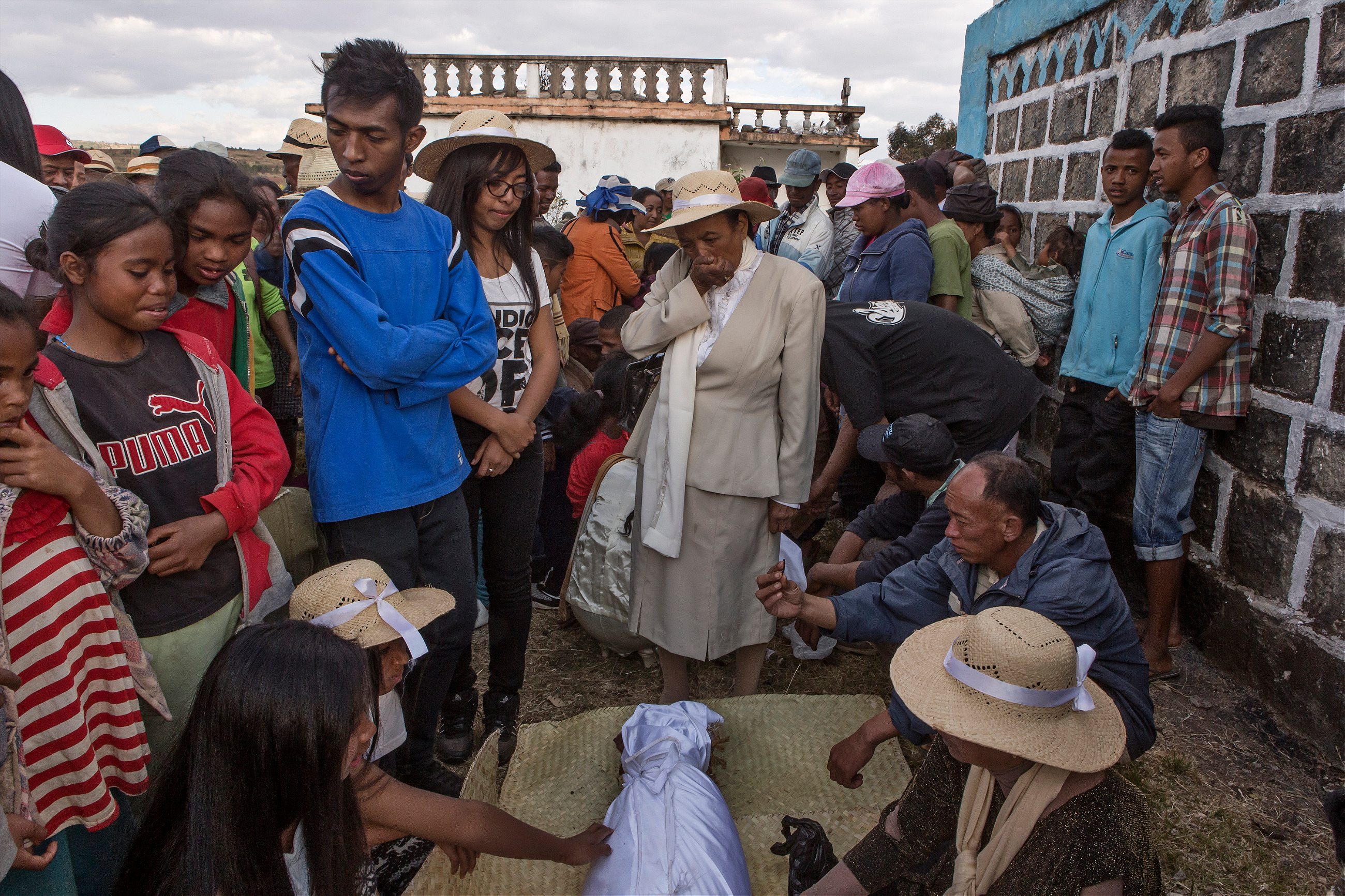
The dead echo through the world, sometimes long after they have left it, but they only do so because they were alive. They only do so through the people they knew, the people they loved and were loved by. They do so because of the things they said and did, the promises, lies, declarations, evasions, achievements, and tantrums. All of this leaves a trace, a signature, among those who remain alive. It has vibrancy and relevance and demands to be acknowledged. The fearful and silent reverence before death and bereavement that is so characteristic of many societies, including mine, is like a carpet that stifles the echoes of the dead.
When all the bodies have been wrapped, each family takes some time with their loved one. Some sit next to the corpse, gently resting a hand on it. One group sits in two rows facing each other, legs extended, the body of their relative lain between them. One family sings a song that starts off slow and mournful but soon breaks down into peals of giggling as different voices and levels of inebriation struggle to get in tune and in time with each other.
After a little while, shouts of “Allez!” rise above the murmur of voices and the band struggles to their feet somewhat reluctantly and strikes up. The mood rises in seconds to the anarchic excitement of the procession and each family hoists their body onto their shoulders. The music swelling, each corpse sets off around the crypt borne on the shoulders of its relatives. They rise and fall and tilt and swerve, colliding with each other and swaying this way and that. One group stops to pump its corpse up into the air and attempt some on-the-spot footwork, causing the group behind to crash into them. Every bump threatens to send the wrapped bodies sliding to the ground and is met with more screeching and hysterical laughter.
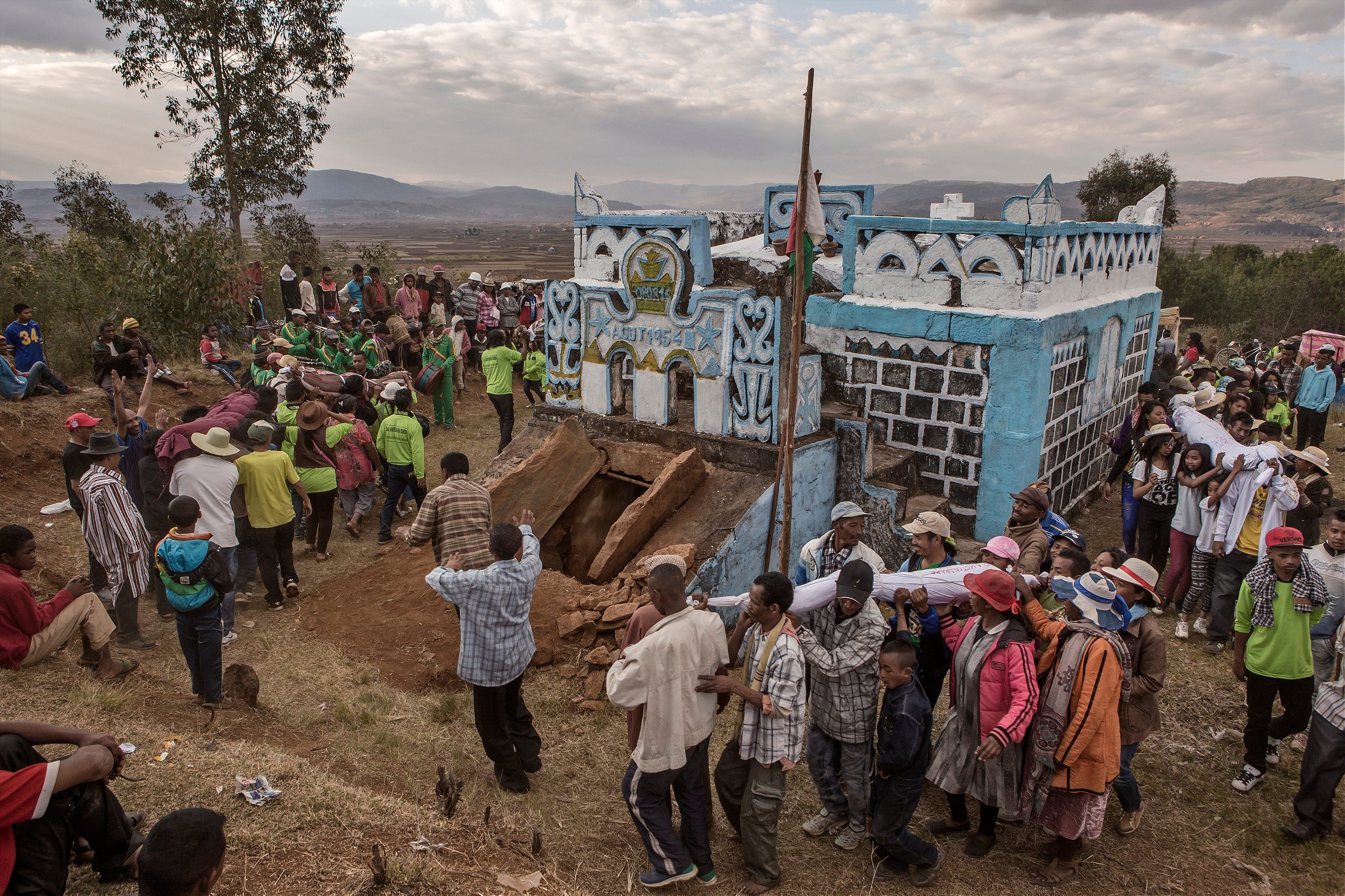
It’s joyous, irreverent, hectic, and chaotic. I climb up the embankment and look over the wheeling, whooping, dancing crowd of family, dead and alive. The valiant band with their hangovers and Lazarus-like instruments keep blasting out rolling, brassy dance music as the bodies haphazardly complete their circuits and are returned to the crypt. Any last shred of tension has fallen from Jules as he realizes that it’s all coming to an end, and that all in all, it went pretty well.
He had said a few days before, “Some think that Famadihana is like desecration. No, exhumation is an act of love! It’s a moment of joy.” Looking over the still dancing, still grinning faces of the Rakotoarisoas and their kin, Jules’ words make more sense than they did when he said them. Hauling these bones and moldering old sheets out of a crypt, sitting with them, drinking with them, and dancing with them acknowledges the love that they represent. Love has its own momentum, which is not halted or even diminished by the death of the one who is loved. Of course, death is scary; that’s why you need to carry a bottle of rum with you into the crypt. But it doesn’t mean you shouldn’t go down there. It doesn’t mean you shouldn’t sometimes dance with your dead.